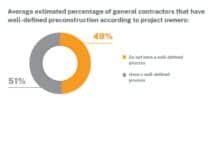 ChatGPT launched in November last year and by January the AI-powered software had become the fastest-growing consumer software application in history, according to figures from UBS, with the rapid adoption of the program raising fresh interest in applying artificial intelligence to solve business problems across industries.
ChatGPT launched in November last year and by January the AI-powered software had become the fastest-growing consumer software application in history, according to figures from UBS, with the rapid adoption of the program raising fresh interest in applying artificial intelligence to solve business problems across industries.
The debut of the OpenAI software fits into a broader upsurge in development and adoption of artificial intelligence applications globally, with JLL research showing that $4 billion in capital was raised last year to fund AI-powered applications for use in the real estate industry.
The surge in AI innovation promises to provide greater productivity and enhanced efficiency for companies ready to leverage new applications of the technology, prompting Mingtiandi and Yardi to make artificial intelligence, and the data management infrastructure necessary to support it, the centrepiece of a tech adoption survey rolled out this week.
The Mingtiandi-Yardi survey, which is available through the link above, is the fourth such study conducted on the platform, and measures the state of AI adoption in Asia’s real estate industry, attitudes and expectations regarding the technology among professionals in the region and tech readiness of property companies operating in the region.
Polling 11,000 Industry Professionals
The survey, which was sent to more than 11,000 Mingtiandi subscribers on 17 July is open for responses until 4 August and asks participants to answer 15 questions about artificial intelligence, their use of technology and their perception of the status tech adoption in the industry.

Companies and countries are preparing for ways to leverage AI’s potential
Among the topics explored are what steps companies have taken to incorporate AI into their businesses, and how organisations are preparing both to implement this enhanced set of tools into their workflows and to get ready for changes to the corporate world wrought by these technologies.
Results of the survey will be prepared into a report measuring both the current state of tech adoption in Asia’s real estate industry, and how the state of the sector compares to the surveys conducted in 2017, 2020 and 2021. Results of this year’s survey will be published during the fourth quarter.
In the most recent Mingtiandi-Yardi tech adoption survey in 2021, 82 percent of respondents said that technology would play a significant or major role in reshaping their workplaces in the coming three years, yet a majority indicated that spreadsheets continued to be their primary tools for managing information.
Now, however, JLL research shows that the $4 billion invested in artificial intelligence applications for the real estate industry last year was double the amount committed a year earlier, with analysts predicting that the burst of investment can help to introduce tools that will streamline workflows and increase efficiency in an industry often associated with manual processes.
Potential for Efficiency
With ChatGPT having demonstrated the enhanced potential for AI implementations relying on generative AI based on large language models, real estate innovators see potential for businesses to improve research and data collection, predict market trends and accelerate due diligence procedures.
As real estate businesses become capable of implementing AI tools to analyse broader data sets, more accurate calculations of NOI and ROI can be produced more quickly. Also, underwriters and lenders will be able to more accurately predict potential returns on deals and better manage liquidity by achieving clearer projections of potential outcomes.
Harnessing AI, however, will require better access to consistent and reliable information, including third-party databases, more systematic management of this data and teams trained in using both the datasets and the analytical tools.
The Mingtiandi-Yardi survey explores how prepared Asia’s real estate industry is for this transformation, with the report set to show where the sector currently stands, what steps companies are taking to prepare for the transformation and what changes we can expect based on current activity.


